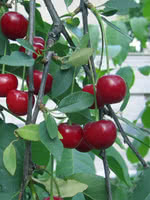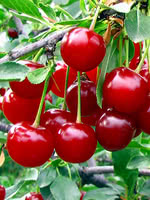Mon-Fri 9am - 5pm Mountain time
Valentine Cherry vs Sour Cherry
Prunus cerasus
Prunus x kerrasis Valentine
NOT AVAILABLE THIS SEASON - MIGHT RETURN
Sour Cherry is cold-hardy and typically grows as a small tree. In late spring, it produces clusters of fragrant white blossoms that mature into bright red, tart fruit. Although the cherries can be eaten fresh, they are most commonly used in baking and preserves.
While not native to North America, Sour Cherry serves as a larval host plant for the Eastern Tiger Swallowtail (Papilio glaucus), a butterfly native to eastern North America.
Sour cherries are self-fertile; however, planting near additional cherry trees for cross-pollination can increase yields.
This Sour Cherry is produced from seed collected from an Evans Cherry and is not clonally reproduced.
Valentine Cherry is a hardy deciduous shrub and hybrid variety of the University of Saskatchewan Sour Cherry released in the Romance Series of dwarf sour cherries in 2004. This medium-sized self-pollinator produces tart, bright red fruits in large clusters in late summer that are perfect for jams, pies and jellies. Valentine Cherry is ideal as a landscape or orchard tree.

